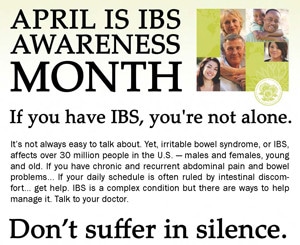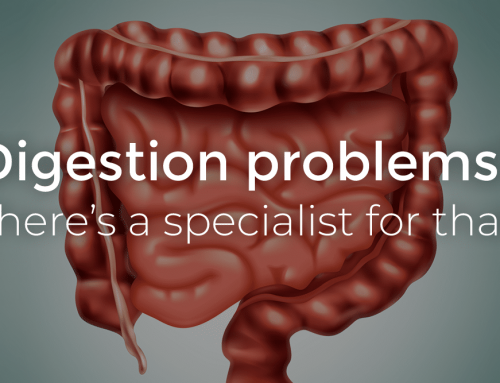With April being the National IBS Awareness month, I wanted to provide some additional information regarding irritable bowel syndrome to help promote awareness for this digestive disorder. The International Foundation for Functional Gastrointestinal Disorders (IFFGD) describes Irritable bowel syndrome (IBS) as a disorder in which abdominal discomfort or pain is associated with a range of symptoms. Typically, these include intermittent abdominal pain accompanied by diarrhea, constipation, or alternating episodes of both. Other symptoms may also be present.

IBS Facts
IBS is a complex disorder that affects millions of people in the United States. Here are some of the prominent statistics regarding IBS that will help put into perspective the prevalence of this disorder.
- IBS affects between 25 and 45 million people in the United States (10 to 15% of the population). About 2 in 3 IBS sufferers are female.
- Most persons with IBS are under the age of 50. But many older adults suffer as well.
- Stress does not cause IBS. However, because of the connection between the brain and the gut, stress can worsen or trigger symptoms.
- Although IBS is common in the general population, few seek medical care for their symptoms.
- IBS can only be diagnosed by a medical professional.
Source: IFFGD
Types of Irritable Bowel Syndrome
You might be more aware that there are different types of IBS after one drug company ran an ad during the last Super Bowl for IBS with diarrhea. In fact, there are three different types of IBS. The types of IBS are: IBS with constipation (IBS-C), IBS with diarrhea (IBS-D), and IBS with alternating constipation and diarrhea (IBS-M).
The reason we break IBS down into the 3 different categories is because the treatments are different. For IBS-C we focus on getting the bowels moving more frequently which can help reduce the distention and bloating associated with it. We try to accomplish this through diet and lifestyle changes as well as medication. For IBS-D the goal is to slow the hyperactive bowels down. We do this with the same process of working on diet and lifestyle triggers and medications. Alternating type IBS is a bit more difficult but the goal is to level the peaks and valleys so there is a more consistent predictable bowel movement while cutting down on the bloating and discomfort as well.
When to see a Doctor in San Antonio, TX
Understanding the different types of IBS can help narrow in on your diagnoses, so you can obtain the proper treatment for your symptoms and specific condition. Keeping a diary of your change in bowel habits can help your doctor better diagnose your symptoms and develop a treatment regimen. Things to write in your diary are dates, description of how bowel habits have changed, any dietary changes and stress.
While there is a lot of information online regarding IBS, its important to remember that IBS can only be diagnosed by a medical professional. Prior to coming to your appointment keep track of your symptoms for a couple weeks along with diet and things like level of stress. Then review this data and see if you can find any specific triggers. Most people that have IBS also have triggers that make their symptoms worse and identifying these triggers can help a lot with treatment options. Then when we sit down and review this data we can come up with a plan together of the best ways to manage the triggers and alleviate the symptoms. Since IBS is a lifetime condition for most people I always try to avoid long term medications if we can. I focus on things like diet and lifestyle changes, trigger avoidance and natural treatments like enzymes, probiotics and Atrantil. If these things don’t work then we have several different types of prescription medications available as well. Bottom line is, don’t let your symptoms go and make it something you just live with. IBS is a controllable condition and there are things we can do to help.






